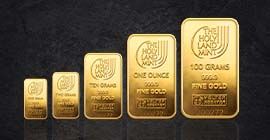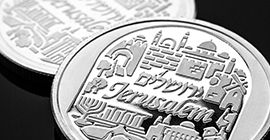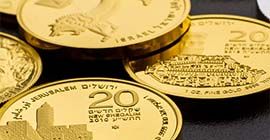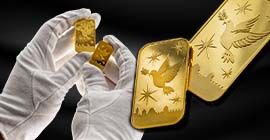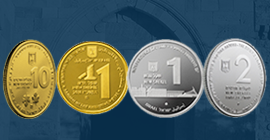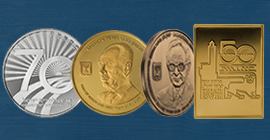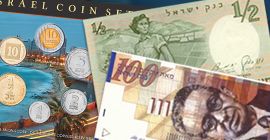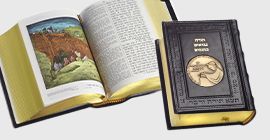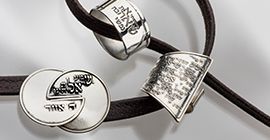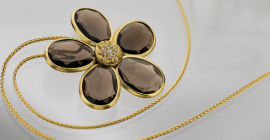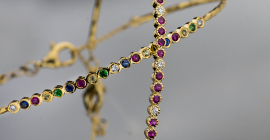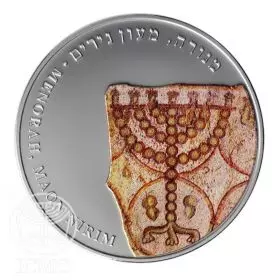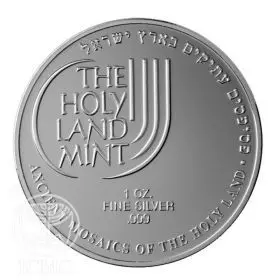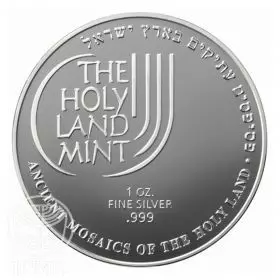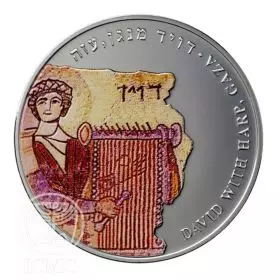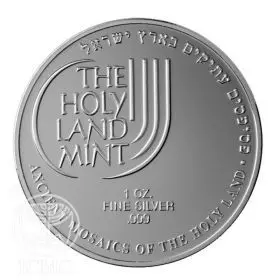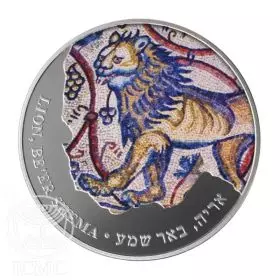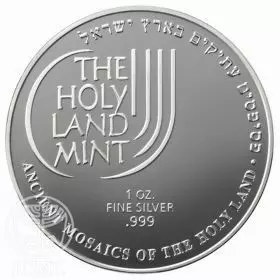Peacock
Silver 999, 38.7 mm, 1 oz.
SKU
21873390
In stock
$209.00
Specifications
| Issuing Year | 2013 |
|---|---|
| Material | Silver |
| Fineness | 999 |
| Weight | 1 oz. |
| Diameter | 38.7 mm |
| Max Mintage | Unavailable Info |
| Design | Meir Eshel |
"PEACOCK" MOSAIC FROM BEIT SHE'AN
6TH MEDAL IN THE "ANCIENT MOSAICS IN THE HOLY LAND" SERIES
Beit She'an is one of the oldest cities in the Land of Israel. Its importance lay in its strategic situation at the crossroads of the routes from west to east (from the Mediterranean coast in the west, through the Zebulun and Jezreel Valleys, across the Jordan in the east) and north to south (the Jordan Valley). The fertile lands of the valleys and the abundance of springs in the region provided an economic advantage for Bet She'an. (The Beit She'an Valley is known today in Israel as the "Valley of Springs"). Archeological research has proved that in ancient times, the city was located on a hill known as the Tel (hill of) Beit She'an, which overlooked the surrounding area.
Beit She'an was part of the territory of the Tribe of Menasseh but because of the military power of the Canaanites of the region, the Tribe of Menasseh was not successful in taking possession of the city. In the time of King Solomon, Beit She'an was located in one of the administrative regions responsible for the valley area. "Solomon had twelve officers over all Israel…", one of whom was Ba'ana, who controlled "Ta'anakh and Megiddo and all of Beit She'an…(Kings I, 7).
From the Hellenistic period, the urban area of Beit She'an grew beyond the original hill. In Roman times, the City became a regional center and its name became Scythopolis. During the Byzantine period, Beit She'an reached the height of its growth and prosperity, developing outwards, around the original hill, in all directions. Its northern part was crossed by the Harod River. During this period, the City was enclosed by a wall, of which remains have been found in different places. In archeological excavations, many structures dating from the Byzantine period have been discovered, attesting to a prosperous economy. The character of the city at the time was mainly Christian, like that of the other settlements that gradually came under the influence of the prevailing Byzantine culture. Nevertheless, there were also Jewish and Samaritan communities in the City.
Over large areas around the Roman-Byzantine City of Scythopolis, were graveyards. Within the area of one of them, Tel Hamam, about one kilometer east of Tel Beit She'an, beyond the northern bank of the Harod River, an archeological dig was carried out in 1934 by the Antiquities Authority of the British Mandate. The archeologists discovered a structure with a central room and two floor mosaics, one on top of the other, one from the beginning of the Byzantine period (4th century), and one from the middle of the 6th century. It is believed that the structure served as a Christian prayer room for people visiting the graveyard.
The mosaic floor discovered is one of the most prestigious and beautiful floors found, with a plaited acanthus plant around its border. In the corners of the border, bearded heads represent the ocean, the big river that surrounds the earth in Greek mythology, and a non-bearded head represents the winds of the heavens (another such head in the opposite corner has seemingly not been preserved). Within the bordered mosaic, artists created an impressive grape design, within which were depictions of agricultural activity and animals. In the center of the lowest row of the mosaic, is a depiction of a vessel out of which vine leaves flow. Two majestic peacocks stand on either side of the vessel, looking towards it. The peacock shown in the fragment of the mosaic on the medal is the peacock from the left-hand-side, standing firmly and proudly, decorated with colorful feathers.
Not far from Tel Hamam, north of Tel Beit She'an, is Tel Itztaba, where a Byzantine Monastery has been discovered. The mosaics discovered at the site resemble those at Tel Hamam. The vine motif with grapes depicting animals in the center, birds and peacocks reappear on these mosaics.
Mosaic artists seem to have been particularly attracted to peacocks. The reason for this was probably their majestic appearance and beauty. Researchers add, however, that birds, and in particular peacocks, symbolize the soul of man and eternal life.
Photography of the Mosaic: Yeshayahu Lander, Courtesy the Israel Antiquities Authority
Edge: Smooth with serial number.
Designer: Meir Eshel.
Mint: USA.
Issue Name: Ancient Mosaics, Peacock
Series Name: Holy Land Ancient Mosaics
| Catalog SKU | Condition | Diameter | Issue Price | Issuing Year | Material | Quantity | Weight |
|---|---|---|---|---|---|---|---|
| 31873390 | 38.7 mm | Unavailable Info | 2013 | Gold 9999 | 360 | 1 oz. | |
| 21873390 | 38.7 mm | 549 NIS | 2013 | Silver 999 | 888 | 1 oz. |

